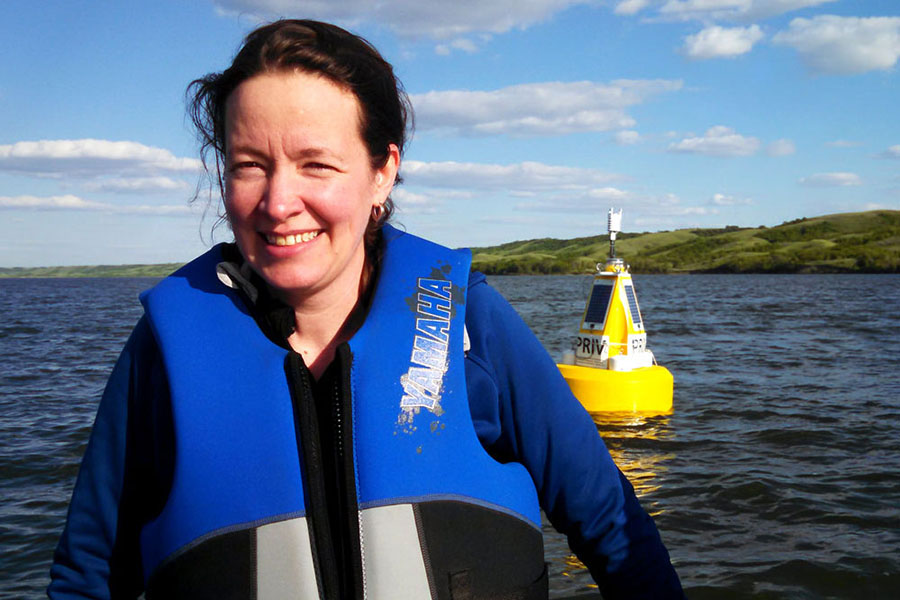
Real-time data aims to improve Regina and Moose Jaw drinking water
GIWS researcher Helen Baulch is leading a project that uses in-lake sensor technology to inform drinking water treatment and source water protection planning on Buffalo Pound Lake.
U of S media release August 11, 2014
Residents of Regina and Moose Jaw who rely on Buffalo Pound Lake for their water supply will soon have a better understanding of their water source thanks to researchers from the University of Saskatchewan and the staff at the Buffalo Pound Water Treatment Plant.
Buffalo Pound Lake is shallow and rich in the nutrients that stimulate blooms of algae each summer. This high-algal productivity makes the water difficult to treat and can impart unpleasant tastes and odours.
“This project is the first of its kind in Canada that uses in-lake sensor technology to inform drinking water treatment and source water protection planning,” said Helen Baulch, assistant professor with the School of Environment and Sustainability and the Global Institute for Water Security at the U of S and lead investigator on the project.
In June, the team deployed an observatory buoy on Buffalo Pound Lake north of Moose Jaw, which is the source of drinking water for a quarter of Saskatchewan’s population. The buoy’s instruments measure temperature, light penetration, oxygen and carbon dioxide levels, chlorophyll and pH levels. It transmits the data back to the researchers and the water treatment plant via a web portal. This near-real-time data will be used to develop computer modelling programs that guide plant operations.
“It allows us to provide warning of changing water quality and gives the water treatment plant time to adapt,” said Baulch.
Summer means warmer weather and with it, blooms of cyanobacteria or blue-green algae. When conditions are ideal, with warmth and plentiful nutrients, the water takes on a distinctive murky, greenish hue. Cyanobacteria are one of the sources behind unpleasant water taste and smell.
Baulch explained that the expertise and experience from the research team partners provide an invaluable foundation for the program. Their “decades of data are of tremendous use to us in understanding the lake ecology, and the ecology of harmful algal blooms.”
Dan Conrad, plant chemist at the Buffalo Pound Water Treatment Plant, explained that there are processes to deal with cyanobacteria and algae. These include physical removal of the algae as well as oxidation or adsorption of their metabolites. Adsorption is achieved by 12 granular activated carbon (GAC) contactors which together contain over one million kilograms of activated carbon. Consumers are very sensitive to the odour of one algal contaminant called geosmin, which can be detected at 10 parts per trillion, an exceedingly small amount (equivalent to the first four millimeters of a journey to the moon).
Although the GAC contactors can reduce geosmin to levels lower than the ten part per trillion odour threshold, they have a limited operational time before they must be taken off line and regenerated. This is an expensive, time-consuming process that also involves regular maintenance of the regeneration facilities.
Conrad is optimistic about the expected results from the study. “By continuously monitoring the lake chemistry for conditions that affect treatment processes, or conditions that may trigger algal blooms, it is our hope that the buoy and its data will also help us optimize the initial physical removal processes and the judicious application of GAC treatment. Other portions of this study will examine searching for other algal metabolites and changes in lake water biota through time. Those historical studies are important when planning effective watershed management plans.”
The buoy will remain on the lake through October, and will be deployed again in spring 2015 and 2016. The project is a collaboration among the Global Institute for Water Security, the Buffalo Pound Water Treatment Plant and the Saskatchewan Water Security Agency, with funding from the Natural Sciences and Engineering Research Council of Canada and the Canada Foundation for Innovation.
-30-
